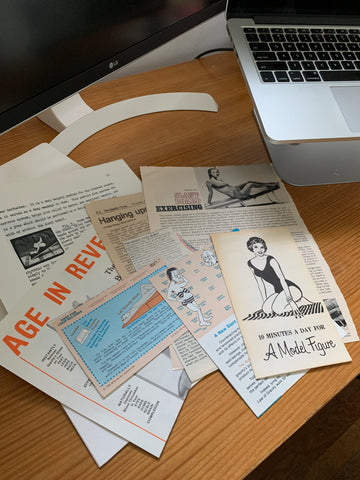When you think of inversion therapy, what comes to mind?
Full inversion A-frame tables? Gravity boots where one is hanging upside down? Acroyoga? Gravity inversion systems? Spinal decompression apparatuses?
It’s simpler than that really.
Inversion, in yoga terms is being in a position with your heart above your head.
I grew up with an inversion slant board (our mom called it an incline board) in our living room. It was the early 70’s and our trailblazing mom was a yoga teacher, massage therapist, vegetarian (sometimes) and advocate of naturopathic health. See our 1st blog - An Intro and a little backstory to hear more.
Seeing her in a variety of inverted poses - headstand, handstand, shoulderstand, and on her navy blue vinyl inversion board, was an everyday occurrence and prompted a bit of eye rolling from my self-conscious pre-teen self. Although, considering I was a gymnast and always upside down, I wasn't one to judge!
Our mom relied on these inversions for relief from varicose veins and I now fully appreciate her need to do so.
In the late 1970s these inversion boards were used with slant board yoga classes and other leotard wearing fitness enthusiasts.
In years earlier, they were popular among Hollywood “Starlets” of the ‘40’s and ‘50’s as a beauty secret, sold at Sears and popularly used until about the 1980's. We write about the history of inversion therapy on our website.

But what is inversion...?
Inversion is a therapeutic way to leverage the power of gravity as a natural form of traction and release to decompress the spine and has been used as a restorative method for thousands of years. Inversions in yoga include standing forward bend, downward-dog pose, legs-up-the-wall, shoulder stand, handstand and such.
Inversion at a low angle, not more than 15 degrees, is known as gentle inversion, low angle inversion or resting inversion. This safe and approachable method invites the body to let go and relax.
Gentle inversion works with the systems in our bodies. It nurtures our whole self and improves our body’s ability to heal.
One simply lies backward with the head at a downward angle and lets go.
A few of the many benefits of inversion:
- Eases back pain
- Relieves stress and muscle tension
- Helps to ease tired and achy legs
- Improves lymphatic and vein circulation
- Clears the mind, enhances ability to focus
According to David Coulter, Ph.D., who taught anatomy at the University of Minnesota for 18 years, when one inverts, tissue fluids of the lower extremities drain—far more effectively than when one is asleep. Areas of congestion clear. In a 1992 Yoga International article on Headstand and the circulatory system, Coulter wrote: "If you can remain in an inverted posture for just 3 to 5 minutes, the blood will not only drain quickly to the heart, but tissue fluids will flow more efficiently into the veins and lymph channels of the lower extremities and of the abdominal and pelvic organs, facilitating a healthier exchange of nutrients and wastes between cells and capillaries."
Beyond physical but intricately intertwined, a beautiful thing happens with regular use of the inversion slant board – it fosters a sensory awareness that can connect us to our whole self, give us a sense of peace and calm – and be a reflective, transformative experience for the mind, heart and spirit.
Next blog, we'll be discussing the many benefits of gentle inversion and why it works so well.
Kick back and stay tuned!
P.S. the cover image is from Anita Colby's book from 1952 called The Beauty Book. She called the inversion slant board the "Hollywood Slant on Beauty" and wrote of it being an essential beauty and anti-aging exercise device.


6 comments
Sep 16, 2019 • Posted by Sweetdreamtonight.com
With so many options available in the market, its so hard to choose one. But Thanks for the Tips/Suggestions.
Aug 12, 2019 • Posted by Angela van Eysinga
This is just what I need to destress and loosen up tight muscles and hopefully get back to good health.
May 28, 2019 • Posted by Kathryn Lenoue
This explains the benefits really well. Great job bringing the medical benefits down to lay level.
May 28, 2019 • Posted by Kay Krizek
This looks so interesting! Where do I go to see the product and find out about the price? Did I miss this information on this website somewhere?
Mar 14, 2019 • Posted by Marie Mills
Interesting article. I have practiced inversion as part of yoga but I wasn’t aware of the benefits when inversion is at such a low-angle. Looking forward to learning more.
Mar 14, 2019 • Posted by Anonymous
Great post!
Leave a comment: